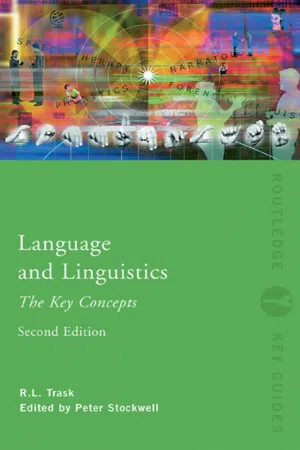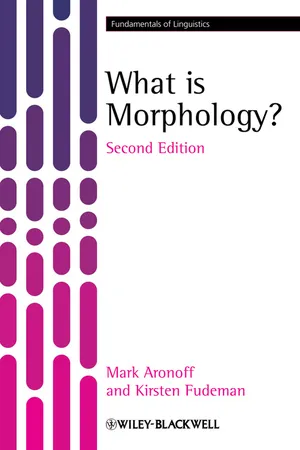Inflection
Inflection refers to the modification of a word to express different grammatical categories such as tense, number, gender, and case. In languages with inflectional morphology, words change their form to convey these grammatical distinctions. Inflection can occur through the addition of suffixes, prefixes, or changes in the root of the word.
6 Key excerpts on "Inflection"
- eBook - ePub
- R.L. Trask, Peter Stockwell(Authors)
- 2007(Publication Date)
- Routledge(Publisher)
...Inflection Variation in the form of a single word for grammatical purposes. In many (not all) languages, a single word can assume any of several different forms, or even dozens of different forms, the choice depending on the grammatical context in which it is used. This is Inflection. A word may be inflected by adding affixes or by various types of internal change. English has very little Inflection, but it does have some. A typical noun has only two grammatical forms: singular and plural (dog/ dogs, child/children, foot/feet). A typical verb has slightly more forms than a noun; for example, write has write, writes, wrote, written, writing, while love has only love, loves, loved, loving, and put has just put, puts, putting. (The number is larger if we count syntactic forms like has written as Inflections, which we sometimes do but usually don’t.) A typical adjective has three inflected forms: positive big, comparative bigger, superlative biggest. Inflection is not universal. Vietnamese, for example, has no Inflection at all, and every word is completely invariable in form. On the other hand, some North American languages have astonishingly complex Inflectional systems, in which a single verb may appear in hundreds of different forms. The key point about Inflection is that applying it never gives you a new word, but only a different form of the same word (the lemma). But derivation, in contrast, does produce new words which have to be entered separately in a dictionary. See also : derivation ; grammatical category ; morphology Further reading : Bauer 1988; Brown and Miller 1991....
- Paul Lennon(Author)
- 2020(Publication Date)
- Routledge(Publisher)
...6 Grammar Inflectional Morphology What Is Inflectional Morphology? Inflectional morphology refers to how the form of a word may change to express grammatical meaning. In English Inflection usually involves adding a suffix (word ending) to the base form, as in ‘give’ (base form), ‘give s ’, ‘giv ing ’, ‘giv en ’. But sometimes it involves a vowel change, as in ‘give’ – ‘g a ve’. Technically, such a vowel change is ‘vowel gradation’ (Crystal 1996: 72) rather than Inflection, but I will include it under Inflection in this chapter. Inflection never changes the word class of the original word: ‘gives’, ‘gave’, ‘giving’ and ‘given’ are all forms of the verb ‘give’. For more on Inflectional morphology see Yule (2017: 75–77). In comparison to some other languages: Latin, Russian and German, for example, English has a slimmed-down system of Inflections. It was not always like this. Old English (c. 700–1100 AD) was much richer than Modern English in Inflection. As English developed over the centuries, however, it gradually lost much of its Inflectional morphology and came to rely increasingly on word combinations and word order to express grammatical meaning. (See Quirk and Wren 1957: 19–58 for more on Old English Inflections.) In English today, Inflection occurs in verbs, nouns and adjectives as well as in personal, possessive, reflexive, relative and interrogative pronouns. There is also the modification of the indefinite article ‘a’ to ‘a n ’, before nouns beginning with a vowel sound. This is really just a pronunciation modification which is shown in the spelling. Verb Inflection In English, verb Inflectional morphology marks person and number as well as tense and aspect. The ‘base form’ of the verb is the uninflected form listed in the dictionary (‘play’, ‘give’, ‘be’, ‘have’ etc.). It is always identical with the infinitive (without ‘to’)...
- eBook - ePub
- Mark Aronoff, Kirsten Fudeman(Authors)
- 2011(Publication Date)
- Wiley-Blackwell(Publisher)
...In Nuuchahnulth and other polysynthetic languages, speakers can build complex words that express what a speaker of English or Vietnamese would express using several words or even an entire, multiword sentence. Following is an example from Nuuchahnulth (Stonham 2004: 65). /k w / is a labialized velar stop; / / is a glottalized labial nasal consonant; / / is a pharyngeal fricative. The final /a/ is a variable-length vowel (see Stonham 2004: 24–6), although not marked as such here. (21) fire-in.house-pl.dim.past-3ind ‘several small fires were burning in the house’ Even English can have one-word sentences. Go! is a perfectly wellformed such utterance. But compared to English, polysynthetic languages are able to express much more complex notions using a single word, including subject, verb, object, and other information. The English gloss of this single Nuuchahnulth word, for example, contains a complex subject noun phrase, a progressive verb, and a prepositional phrase expressing location. 6.6 Summary The term Inflection – “bending” a lexeme – means changing its shape to meet the demands of its syntactic position or environment. Any change in form that is conditioned by syntactic factors counts as Inflection, whether it involves affixation or not. So far in this chapter we have discussed various types of exponence (simple, cumulative, extended), distinguished between inherent and assigned Inflection and between government and concord, and identified Inflectional categories found cross-linguistically. We also discussed ways of distinguishing Inflection from derivation and inventoried possible Inflectional morphology types, which include affixation, stem alternations, apophony, root-andpattern, reduplication, and suppletion. We looked at syncretism and finally morphological typology...
- eBook - ePub
The Psycho-Biology Of Language
AN INTRODUCTION TO DYNAMIC PHILOLOGY
- George Kingsley Zipf(Author)
- 2013(Publication Date)
- Routledge(Publisher)
...Whether (as we suspect from our general experience), actual statistical evidence will support our beliefs, can be determined only by statistical analyses of cross sections of language at different periods of its development. The tenor and the methods of application of the hypothesis have been explained and exemplified; we must now wait for statistical data. In the meantime let us view another aspect of sentence-dynamics, representing the same linguistic phenomena though approached on a different tack. 5. InflectionAL ARRANGEMENT The foregoing discussion of syntax applies primarily to positional or weakly inflected languages. Although a highly inflected language must also arrange its words in the stream of speech, its use of syntactical devices may be insignificant when compared to the uses made of its abundant resources of Inflection. Without some knowledge of Inflection we often cannot understand the peculiar syntactical arrangements of primarily positional, that is, of very mildly inflected languages. For example, the reason why German may always put b 2 at the end of the independent clause while English may not, is probably because b 2 in German, whether it be past participle or infinitive, is always earmarked by an Inflectional ending that identifies it as b 2 and nothing else. Not so English. Verbs and nouns in English often have identical forms (e.g. sleep·, walk, run are nouns or infinitives); past participles are generally marked in English, but not always (e.g. run, come). Anything potentially so ambiguous as b 2 in English cannot stray too far from b 1 without leading to confusion: hence, a German sentence may be more involved than an English sentence before becoming incomprehensible. The more highly inflected a language is, the greater is the liberty which it may take in positional arrangement...
- eBook - ePub
Linguistics for Language Teachers
Lessons for Classroom Practice
- Sunny Park-Johnson, Sarah J. Shin(Authors)
- 2020(Publication Date)
- Routledge(Publisher)
...While plurality is expressed in Spanish (and in English) through the plural suffix -s, an overt affix is not required for expressing singularity. However, some languages inflect both singular and plural nouns. In Luganda, one of the major languages spoken in Uganda, both singular and plural nouns are marked with different prefixes. In the following data from Luganda, notice that the singular morpheme omu- marks a noun as singular while the plural morpheme aba- marks a noun as plural. omu sajja “man” aba sajja “men” omu kazi “woman” aba kazi “women” omu sawo “doctor” aba sawo “doctors” omu sika “heir” aba sika “heirs” omu lenzi “boy” aba lenzi “boys” Another interesting difference in grammatical marking can be found when we compare Finnish to English. In Finnish, nouns are inflected to indicate meanings typically expressed by prepositions such as in, to, and from in English. talo “house” (subject) talo lla “on the house” talo n “house” (object) talo lta “from the house” talo ssa “in the house” talo lle “to the house” talo sta “out of the house” talo a “part of the house” talo on “into the house” talo tta “without the house” Thus, a single inflected noun in Finnish (talossa) is equivalent to an entire prepositional phrase (“in the house”) in English. This example shows that what constitutes a “word” or a “phrase” is not the same in all languages, but rather fluid from one language to another. Understanding cross-linguistic differences like this is important for teachers who are trying to help students gain mastery of second language features. 4.6 Other Morphological Processes In addition to Inflection, different languages use a variety of other morphological processes to form new words. These include compounding, reduplication, internal modification, and suppletion. In the following, we explain each of these with examples. Compounding is the process of building a new word by combining two or more existing words...
- eBook - ePub
A Comparative Typology of English and German
Unifying the Contrasts
- John Hawkins(Author)
- 2015(Publication Date)
- Routledge(Publisher)
...2 Grammatical Morphology DOI: 10.4324/9781315687964-2 In this chapter some important differences in morphology between English and German are considered with particular reference to Inflectional morphemes. Some related general contrasts in derivational morphology and lexical semantics will also be discussed. The main focus of attention will be the case system of German, the semantic and syntactic conditions associated with the uses of the different cases, and the semantic consequences of the loss of Inflectional morphology in the history of English. 2.1 Inflectional Morphology: A Contrastive Overview German has richer Inflectional morphology than English. In general, all the grammatical distinctions that are drawn within English Inflectional morphology are drawn in German as well, though not vice versa. For example, both English and German express a singular/plural distinction on their nouns (E. book/books ; G. Buch/Bücher). Verbs express a past/present tense distinction (E. say/said ; G. sage/sagte). And third person singular pronouns distinguish masculine/feminine/neuter forms (E. he/she/it ; G. er/sie/es). In these three examples the set of grammatical distinctions drawn in English is identical to that drawn in German. But there are numerous grammatical distinctions that are drawn in German Inflectional morphology which are not drawn in English. German has Inflectional morphemes distinguishing four cases within the noun phrase, nominative, accusative, genitive, dative (cf. der Mann, den Mann, des Mannes, dem Mann(e) respectively). English has collapsed its nominative, accusative and dative forms into a common the man, though it still retains a separate genitive the man’s. The definite article the is invariable (as are adjectives). English therefore has two surface cases where German has four. German still has an indicative/subjunctive distinction in its verb, whereas English employs a single form for both (cf...





